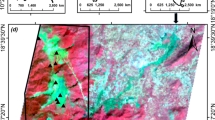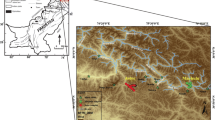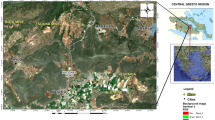Abstract
The ironstone succession at El Gedida-Ghorabi-Naser area of El Bahariya depression is subdivided into lagoonal manganiferous mud and fossiliferous ironstone consisting mainly of hematite and goethite-hydrogoethite. The application of the ASD field spectroradiometer measurements (spectral range) in the ASTER data led to the interpretation of the presence of ferruginous units as quartzitic sandstone, gluconitic sandy clay, and pink marly limestone. The existing iron ore minerals in the iron ore localities were also classified into high Mn hematite, low Mn hematite, goethite, hydrogoethite as well as low- and high-grade Hematite and Barite. Quartz, feldspars, rutile, and clay minerals (e.g., kaolinite and illite) are mainly associated with the iron ore. Accessory minerals of manganese, e.g., psilomelane and pyrolusite, were also present. The Barite mineral is recorded as a common mineral association with the iron ore deposits at El Gedida and Ghorabi localities. The stratigraphical units investigated in the study area include the oldest gravely clayey sandstones of the Bahariya Formation overlain by the fossiliferous and oolitic limestones of the El-Hamra, Qazzun, and Naqb Formations. Quartztic sandstones and clayey sandstones of the Radwan Formation and youngest Quaternary sediments of sandy-clayey materials were often found as intermittent cover and overburden in unconformity surfaces over the iron ore bands.















Similar content being viewed by others
References
Abdel-Monem AA, Korany EA, Youssef AM (2003) Occurrence and genesis of pyrite in El-Gedida iron mine, El-Bahareya depression, Western Desert, Egypt. Sedimentology of Egypt 11:227–238
Ciobota V, Salama W, Tarcea N, Rösch P, El Aref M, Gaupp R, Poppa J (2011) Identification of minerals and organic materials in Middle Eocene ironstones from the Bahariya Depression in the Western Desert of Egypt by means of micro-Raman spectroscopy. (wileyonlinelibrary.com). doi:10.1002/jrs.3047
El-akkad S, Issawi B (1963) Geology and iron ore deposits of the Bahariya Oases, Geol. Surv., Egypt., Cairo., Paper No. 18, 301 p
El-Aref M (1999) Achievements of the Egyptian Iron Exploration Project (IEP, 1993–1997). Proceedings of the Fourth International Conference on Geology of the Arab World, Cairo University, Egypt (1998). Geology of the Arab World (Hafez et al., eds.), 10–22
El-Aref M, Lotfy ZH (1989) Genetic karst significance of the iron ore deposits of El-Bahariya Oases, Western, vol XV. Annal Geol. Surv. Egypt, Desert, pp 1–30
El-Sharkawi MA, Higazi MM, Khalil NA (1983) Three genetic iron ore bodies of iron-ores at El-Gedida Mine, Western Desert, Egypt. 21st Annual meeting of the Geological Society of Egypt, Cairo, Egypt (Abstract)
El-Sharkawy, M.A., Khalil, M.A. (1977) Glauconite: a possible source of iron for El-Gedida iron ore deposits, Bahariya Oases, Egypt: Egypt, Jour. Geol., No 21, PP. 109 -116.
Moustafa AR, Saoudi A, Moubasher A, Ibrahim IM, Molokhia H, Schwartz B (2003) Structural setting and tectonic evolution of the Bahariya Depression, Western Desert, Egypt Geo Arabia, Vol. 8, No. 1, 2003 Gulf PetroLink, Bahrain
Ramakrishnan D, Bharti R (2015) Hyperspectral remote sensing and geological applications. Curr Sci 108 (no. 5)
Salama W (2013) Depression, Western Desert, Egypt, Geobiology, vol 11. pp 15–28
Salama W, El Aref MM, Gaupp R (2013) Mineral evolution and processes of ferruginous microbialite accretion—an example from the Middle Eocene stromatolitic and ooidal ironstones of the Bahariya
Soliman SM, El-Badry O (1980) Petrology and tectonic framework of the Cretacous, Bahariya Oasis, Egypt. Egypt Jour Geol 24(12):11–51
Tian Q (2012) Study on oil-gas reservoir detecting methods using hyperspectral remote sensing. International Archives of the Photogrammetry, Remote Sensing and Spatial Information Sciences, Volume XXXIX-B7
Tukiainen T, Thomassen B (2010) Application of airborne hyperspectral data to mineral exploration in North-East Greenland. © GEUS, 2010. Geological Survey of Denmark and Greenland Bulletin 20, 71–74. Open Access: www.geus.dk/publications/bull
Youssef AM (1991) Mineralogical and geochemical studies of the iron mineralization in the western part of El-Gedida Iron Mine, Bahariya Oasis, Egypt: M. Sc. Thesis, Fac. Sci., Ain Shams Univ., 114p
Acknowledgements
Great thanks to the National Authority for Remote Sensing and Space Sciences (NARSS) for providing the hyperspectral data and chemical analysis to this study. Thanks also to NARSS team work of the iron project supervised by Prof. Dr. Mahmoud Hussein and Prof. Dr. Mamdouh Abdeen.
Author information
Authors and Affiliations
Corresponding author
Rights and permissions
About this article
Cite this article
Salem, S. ASD field hyperspectral measurements for discrimination of the ferruginous rocks and the iron ore types at El Gedida-Ghorabi area, Bahariya Oasis, Western Desert, Egypt. Arab J Geosci 10, 166 (2017). https://doi.org/10.1007/s12517-017-2944-x
Received:
Accepted:
Published:
DOI: https://doi.org/10.1007/s12517-017-2944-x




